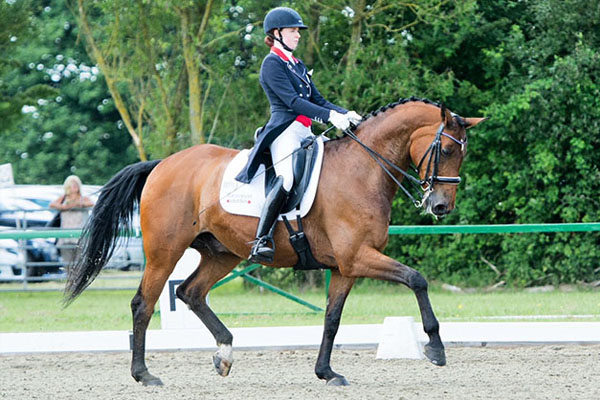Equestrian Rider: Level 5
Course Description: While not everyone wants to concentrate on jumping, every intermediate rider should be able to stay in balance and assume the jumping position even if only to leap over a puddle or fallen log on a trail ride. This should be done without interfering with the horse’s jumping effort. Work over poles and cavalettis can be incorporated into flatwork. Basic flatwork and the repetition required to perfect it can be boring for horses and riders. Working over poles and cavalettis can help to create an interesting learning environment, as well as providing the horse and rider many positive benefits.
Upon completion of this course you will be able to;
- Understand the basics of riding a course over poles at the trot.
- Understand stirrup length and the jumping position.
- Describe different mane releases and when they should be used.
- Describe the purpose of the gymnastic and the benefits for the horse/rider.
- Describe and understand the distances for a gymnastic.
- Understand the horse’s jumping effort and the phases over the fence.
- Understand the importance of finding the right distance to jump a fence.
- Understand how to correct refusals and run-outs.
- Understand common rider faults and how to correct them.
Rider 5 Course will be of interest to all riders or future riders who wish to improve their knowledge and skill in understanding the basics of jumping.
Rider 5
Riders at Level 5 have a solid awareness of a horse moving forward willingly, maintaining rhythm and relaxation. Riders should be able to recognize “tracking up” or lack there of, by observing other horses. This level introduces non-progressive transitions walk to canter/halt to trot. The rider should know the five different rein aids and their influence on the horse.
Attire at this level should be as per lower levels except that riders will now be expected to wear either breeches with tall boots, very well fitted half chaps, or jodhpurs with short boots complete with garter straps and pant clips.
The horse should be presented for the test well groomed with mane neatly laid over and trimmed to an acceptable length as applicable to the breed. Tack should be clean and well oiled. The rider should be aware of the fitting of tack to the horse, aware of how well the tack fits the rider, and how the tack may affect the balance and position of the rider.
Riders at this level will be jumping fences at a height of 2’3” (.7m).
Rider 5 – Stable Management Requirements
Turnout for stable management should be neat and workmanlike. Paddock boots, work boots, or riding boots and neat sweat pants or slush pants over breeches are acceptable. Loose, baggy jeans or shirts are not
acceptable. Hair should be tied back. Ball caps that cover the eyes are discouraged.
Candidates will be expected to:
- Demonstrate how to take the temperature, pulse and respiration of a horse and know the normal values. Using a stethoscope is acceptable
- Know how the body uses water
- Candidates should know the signs exhibited by a horse when its teeth need floating.
- Name some skin conditions and possible treatment
- Understand pressure points that are acted upon by bits
Rider 5 – Riding requirements (Flat)
Riders will be required to demonstrate:
- The action of the rein and the effect that the rein should have
- Dropping and regaining stirrups at canter
- Bend and rhythm in circles 15m (trot) – 20m (canter).
- Half – turn on the forehand
- The correct shape in serpentines, e. circles connected by 2 or 3 steps of straightness.
- Accurate lead changes through trot.
- Accurate and smooth transitions.
- Non-progressive transitions (walk to canter/halt to trot).
Lunging – This is an introduction to lunging only. The candidates must demonstrate the safe handling of the lunge line and whip, and show a change of direction. Horse should be equipped with saddle and bridle, protective boots and/or bandages. A halter used over the bridle is acceptable. Candidates can share a lunge horse if needed. Use of body language, control and confidence will be evaluated.
Rider 5 – Riding requirements (Jumping)
Riders will be required to:
- Trot, with stirrups, into a cross rail, 18’ (5.5m) to vertical then 21’(6.4m) to 2’(61cm) – 2’3”(70cm) oxer, demonstrating a short, medium and long crest release while maintaining
- Trot a single X-Rail without stirrups maintaining position and demonstrating confidence and
- Know that their pace on approach will affect the inside distance in the line and be able to tell the evaluator if they were long or tight (deep) to the second fence in the line.
- Demonstrate control, presentation and confidence.
Rider 5 – Gymnastic
Trot placing pole Crossrail
Suggested Courses for Rider 5 Tests
(Evaluators to walk and approve before testing).
8-9 feet (2.40 m-2.70 m)
16-18 feet (4.90 m-5.50 m)
19-21 feet (5.80 m-6.40 m)

Rider 5 – Course
Trotting an X without stirrups
8-9 feet (2.40 m-2.70 m)
NB: The distances between the poles will depend on the size of the horse/pony.
Rider 5 – Flat Test
| Number | Markers | Movement | Work Space |
| 1 | A | Enter Sitting trot | |
| 2 | X | Halt from trot. Continue at rising trot from halt | |
| 3 | C | Track right | |
| 4 | B | 15m circle sitting trot | |
| 5 | A-C | 3 loop serpentine wall to wall posting trot | |
| 6 | C | Canter right lead | |
| 7 | B | 20m circle | |
| 8 | F | Posting trot | |
| 9 | KXM | Change rein posting trot | |
| 10 | E | 15m circle sitting trot | |
| 11 | A | Canter | |
| 12 | B | 20m circle | |
| 13 | M | Trot rising | |
| 14 | H | Walk | |
| 15 | E | Halt. 1/2 turn on the forehand, continue at walk | |
| 16 | H | Canter right lead | |
| 17 | MXK | Change rein simple change through trot | |
| 18 | A | Trot sitting | |
| 19 | F | Walk | |
| 20 | B | Halt. 1/2 turn on forehand, continue at walk | |
| 21 | F | Trot sitting | |
| 22 | A | Turn down center line | |
| 23 | X | Halt. Leave the arena on a long rein. |
Course Features
- Lectures 17
- Quizzes 0
- Duration Lifetime access
- Skill level All levels
- Language English
- Students 59
- Certificate Yes
- Assessments Yes







